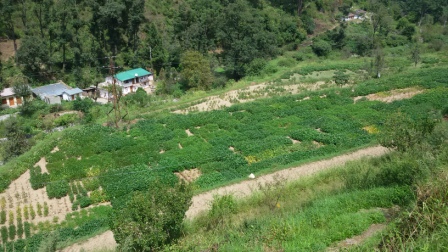The White Side Of Black Beans
genomes of black soyabean landraces at NBPGR Bhowali

Black to look at and an almost rustic texture wise, there is hardly any doubt that despite its distinct aroma and highly palatable taste ‘Maichulas’ is a staple in the diet made of kala bhatt, or black soyabean consumed from November to June, in ‘Chakata region’ corresponding to the modern Bhimtal and Nainital townships of Uttarakhand
It will not be out of place to mention here that kala bhatt or black soybeans, with a wide variety of genomes (over 45 in Uttarakhand alone) grown in the semi-arid, stony and rain fed slopes of Chakata hills in the Central Himalayas, are famous all over for their taste and fetch comparatively a good price.
“For cooking maichulas” says Rashmi, a housewife from Bhimtal, “fresh bhatt are grinded, preferably in a water mill.” The course flour is then kneaded and on a pastry board is cut into small rectangular pieces. These pieces are put in boiling water in an iron cauldron with two spoonful of mustard oil and a pinch of salt. Paste of rice is used to thicken the soup and finally the boiling stuff is tempered with fresh leaves of duna (allium), heeng (asafoetida), zeera (cumin seeds) some other regular condiments and garnished with green coriander. “Eating it with steamed rice,” she adds”, is a lifetime experience.”
Harvested in the month of Oct-Nov and eaten regularly till the next sowing season i.e. June-July, kala bhatt is eaten as dal which is quite crunchy and called chulkani locally. Sumptuous dubkas are also made of the paste of the soaked seeds of bhatt and it is the main ingredient in yet another delicacy called rus which is the filtered and highly spicy soup of so many hill pulses. Baked beans of bhatt are also eaten as munch with tea, especially when it is snowing outside. Interestingly, all dishes of bhatt are cooked in iron cauldron, which besides enriching it in iron does add to its black appearance also. Scratching with an iron ladle the black thickening layered along the brim of the cauldron during the course of cooking and eating this extremely tasty stuff having a pungent aroma with the last few morsels of rice is considered to be the special privilege of the lady of the house.
Grown presently in 5548 ha of rainfed land in the Central Himalayan region of Uttarakhand as a kharif crop, the total production of black soya bean in hills is around 4981 metric tons. Besides being a staple diet of hill folk it has of late acquired the status of cash crop also and is sold for Rs 100/ kg in local bazaars. Black soybeans and its soy products are the richest sources of isoflavones in the human diet. Their consumption is considered beneficial, with a potentially protective effect against a number of chronic diseases). Black soybeans also reduce cholesterol level, inhibit growth of cancerous cells and interestingly, people consuming black soybean in Japan were found less affected by pollution and adverse effects of radiation.
The Journal of Nutrition and Nutrition Reviews endorsed black soybean’s curative powers and its iron and protein content – making it an excellent meat substitute. It is also found of extreme help in managing diseases like jaundice, beriberi, lockjaw, promotes blood circulation and reduces cholesterol. The disease called kwashiorkor, caused by high carbohydrate and low protein diet and otherwise so common in India is totally absent in the hilly region of hills, thanks to the regular consumption of bhatt by hill people.
The Uttarakhand government has recently taken a decision to add bhat-ki-dal in the patients’ menu of govt hospitals in the state. It is unfortunate that the area under this crop has shrunk drastically following the formation of hill state and organized efforts are being made to replace it with a particular variety pigeon pea developed specially for hill slopes under the name VL Arhar-1. National Bureau of Plant Genetic Research (NBPGR) at Bhowali has preserved quite a few acclimatized landraces of kala bhatt in its research farm.
(Written under the aegis of CSE Media Fellowships)



